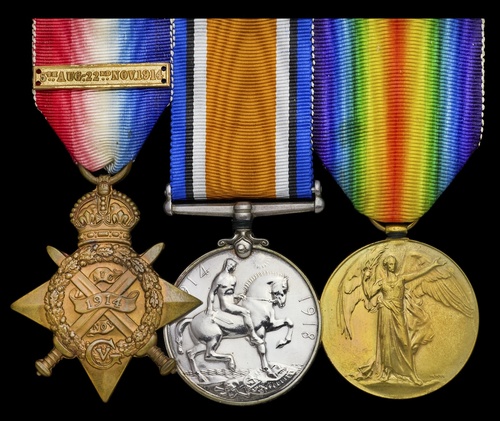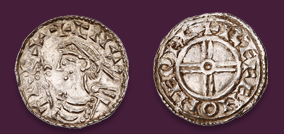
Auction: 24113 - Orders, Decorations and Medals - e-Auction
Lot: 437
A Great War group of three awarded to Private J. Ingram, Worcestershire Regiment, who was severely wounded on 26 September 1915
1914 Star, copy clasp (12700 Pte J. Ingram. 1/Worc: R.); British War and Victory Medals (12700 Pte J. Ingram. Worc. R.), good very fine (3)
John Ingram was born in Bordesley, Birmingham circa February/March 1892 and enlisted into the Worcestershire Regiment at the age of 19 on 5 October 1911 at Birmingham after working as a 'hawker'. On 10 October 1911, Ingram joined his regiment at the Depot at Worcester and on 4 January 1912 was posted to the 1st Battalion. Ingram went with the 1st Battalion to Egypt (where they remained until the outbreak of the First World War) on 22 January 1915. On 15 October 1913, in the warm waters off Egypt, he gained his swimming certificate.
In the opening months of the War, losses were high and there was a need to recall regular troops from overseas service in the colonies to reinforce the troops in France and Belgium. The 1st Battalion were recalled and left Alexandria on 30 September 1914 aboard the troopship Deseado, once in the Atlantic escorted by H.M.S. King Alfred. Due to the threat of German U-Boats, the original destination was changed from Southampton to Liverpool, where they arrived at 9.15 pm on 16 October and afterwards entrained for Winchester. Two weeks of training followed at Hursley Park, near Winchester where the 8th Division was being formed.
The whole Division marched to Southampton on 5 November along streets of cheering well-wishers and onto the transport ship Maidan. It sailed just before midnight and arrived at Le Havre the following morning. However, due to logistical problems, the Battalion did not disembark until 8 November and were entrained for the front the following day.
Ingram got his first taste of action on 14 November when the Battalion relieved the 1st Royal Scots in the trenches facing Neuve Chapelle while under heavy enemy fire. No losses occurred until 15 November, when the enemy heavy howitzers bombarded the Battalion's line, resulting in 32 casualties (7 killed, 25 wounded). For the next four days, the Battalion was shelled continuously which proved trying for the new troops fresh from Egypt, particularly when 'several sharp little fights with the enemys' patrols' were experienced.
The weather by this time had turned to continuous rain and freezing temperatures. With virtually no cover from the elements, the troops began to deteriorate; then came the frost and snow and finally when the call came to withdraw, a march of six miles was made with frost bitten feet and hands. One man in four was suffering these effects and nearly 150 serious cases were sent to hospital for treatment, many had to have feet or toes amputated.
Ingram was one of those who suffered these effects, and was taken ill with rheumatism on 19 November 1914 and transported to the 26th Field Ambulance Station, then onto Mouville for treatment. On 20 November, he was diagnosed as having rheumatic fever and on 1 December disembarked for England on the Hospital Ship St. David with frost bite to his feet, arriving on 2 December.
Remaining in England for a time, Ingram was posted to the 5th (Militia) Battalion on 5 February 1915 and finally returned to France on 22 April. He was posted to the 2nd Battalion, based in billets at Bethune and undergoing training and refitting. Here they remained until 3 May, whereupon they occupied front line trenches.
Ingram took part in the hard Battle of Festubert on 14 May, where great gallantry was displayed by the officers and men of the Battalion, earning five DCM's and one DSO.
In June, the Battalion moved back to the area of Bethune and in August, to Givenchy. As a result of much planning for the great push of the 1915 Autumn Offensive, on 24 September orders were received for the attack on Loos. The 2nd Worcester Regiment were to be in Brigade Reserve at Givenchy. The thunder of the British Artillery opened the Battle of Loos on 25 September and at 6.30 am, the Infantry went 'over the top'.
Attacks on The Quarries and Cite St. Elie had been beaten back and the 2nd Worcesters were called upon (by a series of confusing instructions and map references) to leave Givenchy and make for the communication trench at Vermelles - they were to lead the counter attack.
It was not until 4.45 pm on 26 September that the order to advance and attack was given. 'C' and 'D' Companys were leading with 'A' and 'B' Companys following, forming two lines with bayonets fixed and 'at a steady double' the Battalion crossed the former no-mans land. On reaching the old German trench, occupied by wounded 7th Division men, the Battalion reorganised itself under heavy fire and the advance was given again by Lieutenant Colonel Lambton.
The Battalion advanced in short rushes, sections laying down covering fire alternately, but suffered heavily when 'the German rifles and machine guns opened a devastating fire. Officers and men went down in rapid succession under a hail of bullets', (Regimental History, refers). The survivors reached a half dug trench about 200 yards from the enemy position and attempted to reorganise themselves in preparation for the final bayonet charge on The Quarries. At this, a Brigade Staff Major rushed up and cancelled the attack, as the enemy had a strongly defended occupation of the position and it was believed that without a large supply of bombs necessary to consolidate the attack, it would fail.
Darkness was waited upon and when it came, a safe withdrawal could occur and an account made of the losses. These were high, 13 officers and 300 N.C.O's and men had become casualties, while 500 men remained to answer the muster. Rifle fire was sharp and all through the night and the following morning, the threat of a counter attack remained high.
Ingram had become one of the casualties, he was wounded on 26th September near Vermelles. He had received a bullet wound to his upper left arm and was evacuated to Rouen, being admitted on 30 September and then returned to England on 1 October. Following treatment, Ingram's left arm continued to trouble him, despite an operation to re-connect the muscles on 11 March 1916. The operation returned some of the power to his hand and wrist, but there still existed a 'marked weakness of both extensors and flexors of wrist and fingers' and the incapacity would be permanent. On 28 August 1916, a medical board discharged Ingram from service as medically unfit and placed him in receipt of a pension, at the age of 24.
Following a medical board on 30 January 1920, Ingram's disability was assessed at 20%, and a pension of £52 10s per year was granted.
Ingram had served a total of 4 years and 328 days and upon discharge, gave his address as 11 Mansion Place, Filton Road, Small Heath, Birmingham to reside with his younger brother, Charles. His 'conduct during his service had been good. Is sober, honest, hardworking, willing and trustworthy'.
Subject to 20% VAT on Buyer’s Premium. For more information please view Terms and Conditions for Buyers.
Estimate
£240 to £280
Starting price
£220




